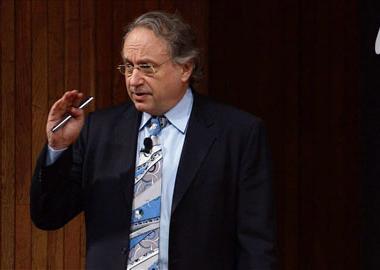 Moore’s law and energy efficiency emerge as themes in these two lectures on past and future progress in microprocessors and robotics.
Moore’s law and energy efficiency emerge as themes in these two lectures on past and future progress in microprocessors and robotics.Back in the old days, recalls Rodney Brooks, people were not allowed near computers, because the smoke from human cigarettes might damage delicate machinery. Then humans had to steer clear of robots, lest they come out on the losing end of an encounter with a hulking machine limb. But following the explosion of PC and portable computing technology, the last 10 years have brought robots into close proximity with people. Brooks says more than nine thousand robots now serve in the U.S. military, and six million work in human homes -- including his own line at iRobot.
Brooks attributes this proliferation of AI aides to “IT exponentials that beget other exponentials.” Leaps in processing speed enormously aided in the development of essential robotics systems, such as vision, machine learning, wireless networking, and speech understanding. He shows a robot, “The Cart,” from Stanford’s AI lab circa 1979. The device relied on a giant mainframe (shared with the music department), and moved 20 meters in six hours. By 2005, Stanford’s AI
vehicle Stanley was traveling 200 kilometers in six hours. Brooks runs videos of the latest robotic achievements, such as following a human’s gaze and commands and delicately manipulating objects. Roboticists have a way to go before their creations can recognize a class of objects such as a shoe and pick out speech in a noisy background.
Much of these advances will depend on a continuation of the progress in computing power that has been driving the digital revolution. John Hennessy believes that we will soon reach an “incredible inflection point,” when desk-based computing will give way to tablets and smart phones—“a land grab evolution of internet access.” In addition, the number of servers in clouds is expected to grow by more than 30% a year. What this means, he says, is that “energy will be a key factor in determining how useful devices are.” The costs of powering and cooling all these devices, not to mention giant server farms, will increasingly impact their design and performance.
Hennessy offers a brief history of the connections among computer architecture, speed, and energy efficiency since the late 1970s. Today, the Jaguar of the processing world, Intel’s Core i7 has a detector that slows down its clock rate if the chip gets too hot, says Hennessy. Researchers eager to maintain steady progress in performance while keeping transistors cool are exploring variations on multithreading and multicore devices, some with simpler memory hierarchies, others with aggressive memory hierarchies. The desired outcome would permit the portability of these processors across architectures “so we don’t have to turn every single programmer into a hardware architecture expert,” says Hennessy....Read the full article/Watch Video
Much of these advances will depend on a continuation of the progress in computing power that has been driving the digital revolution. John Hennessy believes that we will soon reach an “incredible inflection point,” when desk-based computing will give way to tablets and smart phones—“a land grab evolution of internet access.” In addition, the number of servers in clouds is expected to grow by more than 30% a year. What this means, he says, is that “energy will be a key factor in determining how useful devices are.” The costs of powering and cooling all these devices, not to mention giant server farms, will increasingly impact their design and performance.
Hennessy offers a brief history of the connections among computer architecture, speed, and energy efficiency since the late 1970s. Today, the Jaguar of the processing world, Intel’s Core i7 has a detector that slows down its clock rate if the chip gets too hot, says Hennessy. Researchers eager to maintain steady progress in performance while keeping transistors cool are exploring variations on multithreading and multicore devices, some with simpler memory hierarchies, others with aggressive memory hierarchies. The desired outcome would permit the portability of these processors across architectures “so we don’t have to turn every single programmer into a hardware architecture expert,” says Hennessy....Read the full article/Watch Video
For more techical information visit our sister website www.engineeringmaintenance.info or for equipment procurement please visit www.engineeringtrader.com

